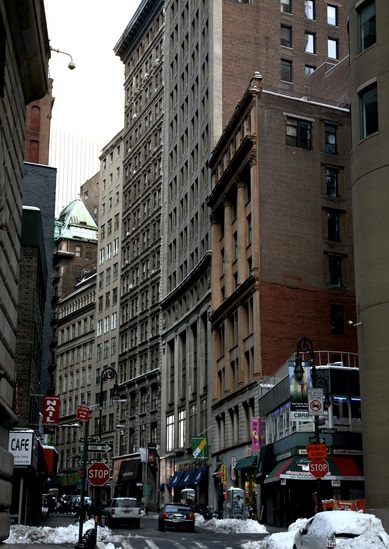 Maiden Lane: New York English Academy’s New Home
October 29, 2014
Maiden Lane: New York English Academy’s New Home
October 29, 2014
While the streets of Manhattan may feel like a meeting point for everything that is modern, high tech, and new in the world, they also have a deep history made up of natural and human-made disasters, tragic stories, and continuing urban and architectural innovations. As you walk to your English classes at 80 Maiden Lane, you may be interested to know that the history behind this street, with its mix of sky-high business towers, charming shops, and inviting restaurants, is old as New York itself and includes stories about lovers, slaves, political figures and more.
Old New York’s Maiden Lane
As one of New York City’s oldest streets, Maiden Lane’s name comes from a Dutch abbreviation for “Maagde Paatje,” which translates to “Maiden Path.” The street’s name was inspired by its location alongside a small waterway. The first reason was due to the street’s popularity with young couples for its charming stream, which was used as a setting for romantic walks on lazy afternoons. The second reason was because the street’s nearby access to water provided a good location for the neighborhood’s mothers and daughters to do their laundry.
In the beginning of the 17th century, Maiden Lane became a main path to the food vendors marketplace, called the Fly Market; another mispronounced name coming from the Dutch term, “vly,” which mean “valley.” While you might think it could be fun to take a trip back in time and visit the Fly Market, learning that it was closed almost 200 hundred years ago at the request of locals due to it being unsafe, unhygienic, and an eyesore, would probably make you think twice.
The 18th century saw a lot of bloodshed on Maiden Lane as it was the scene of New York’s first slave revolt in 1712. Also, as the United States gained its independence in the second half of the 18th century, New York was proclaimed the country’s capitol, leading several of the most important politicians of the time to take residence in the city. Maiden Lane was thus home to Thomas Jefferson for a short period.
Maiden Lane: A Road to Prosperity
The prosperous 19th and 20th centuries brought a series of transformations to Maiden Lane, changing it from a calm residential street into a well-lit shopping paradise. Modern gas lamps provided safety at any hour of the night while new, more elaborate buildings constructed in the neoclassical and beaux-arts styles decorated the street. Some of this charming, old New York architecture can still be found on buildings to this day in what is now Manhattan’s Financial District.
A lover’s path, slave trading, political figures, and the industrial and commercial revolution are all a part of Maiden Lane’s story. Today the street boasts a well-preserved mix of old and new, of charming and modern—a true representation of everything New York City is about.
Archive
- October 2023
- August 2023
- July 2023
- June 2023
- May 2023
- April 2023
- March 2023
- February 2023
- January 2023
- November 2022
- October 2022
- August 2019
- July 2019
- June 2019
- May 2019
- April 2019
- March 2019
- February 2019
- December 2018
- October 2018
- September 2018
- August 2018
- July 2018
- June 2018
- May 2018
- April 2018
- March 2018
- February 2018
- January 2018
- December 2017
- November 2017
- October 2017
- June 2017
- April 2017
- March 2017
- February 2017
- January 2017
- December 2016
- November 2016
- October 2016
- September 2016
- August 2016
- July 2016
- June 2016
- May 2016
- April 2016
- March 2016
- February 2016
- January 2016
- December 2015
- November 2015
- September 2015
- August 2015
- July 2015
- June 2015
- May 2015
- April 2015
- February 2015
- January 2015
- November 2014
- October 2014
- September 2014
- August 2014
- July 2014
- June 2014
- May 2014
- April 2014
- March 2014
- February 2014
- January 2014
- December 2013
- November 2013
- October 2013
- September 2013
- August 2013
- July 2013
- June 2013
- May 2013
- April 2013
- March 2013
- February 2013
- January 2013
- December 2012
- November 2012
- October 2012
- September 2012
- August 2012
- July 2012






